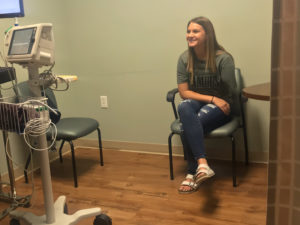DeWitt Teen Finds New Ways to Move After Losing Arm
| Mother’s Day 2019 was a terrifying one for Katy Watson of DeWitt. She received a call that her 15-year-old daughter, Kenlee St. John, had been involved in an accident. St. John was riding with a friend in a utility vehicle commonly known as a side-by-side.
“We hit uneven ground and it flipped, landing on my arm,” St. John said.
Her arm was severed. Quick-thinking bystanders applied a tourniquet and put the arm on ice.
She was flown to Arkansas Children’s Hospital, where UAMS hand surgeons Mark Tait, M.D., and John Bracey, M.D., worked to reattach her arm.
“We were initially able to replant her arm successfully with very promising early results,” Tait said, “but because of the significant contamination of the amputated arm, she developed a severe fungal infection, which ultimately led to the failure of the replantation.”
“I just wanted her to have the most fulfilling life,” Watson said. “That was my prayer. If that included her arm, great — but I was more interested in the arm being fully functional.”
St. John spent 21 days in the hospital. She’s made impressive progress since she’s been home. Rarely seen without a smile, the multi-sport athlete and honor roll student has found new ways to practice her cheerleading, basketball, track and softball skills.
She went to cheer camp in July and is able to do a standing back tuck flip.
“It feels good to be back at practice,” she said. “I’ve been doing a little bit of everything since I’ve been home.”
St. John and her family have gone twice to a new amputee clinic offered at UAMS. For one day each month, a multidisciplinary team focuses on upper extremity amputations.
Occupational therapist Angela Green said the clinic makes it easier for patients because they don’t have to make multiple appointments with a therapist, their surgeon and prosthetics specialist. They’re all in the room together, assessing the patient’s needs.
“Patients don’t always know what the steps are if they have an amputation and need a prosthesis,” Green said. “The team approach helps us treat our patients holistically. Dr. Bracey and Dr. Tait are extremely skilled surgeons and not only care about their patients surgery outcomes, but truly want their patients to succeed. They want to see their patients through the whole process, which includes the patients achieving their goals with prosthetics.”
The clinic has potential to make a significant impact on an underserved population.
“We see several cases a year similar to Kenlee’s and have also seen others as a result of four-wheelers,” Tait said. “The modern surgical techniques in upper extremity amputations can lead to decreased pain, higher functioning patients, and improved technological prosthetic options and can even help in patients who have had amputations many years ago.”
Green said this team approach provides education, resources and intervention and makes the most of the patient’s time. Many of them travel across the state, and some from surrounding states.
The clinic is for anyone with an upper limb amputation, including multiple fingers, partial hand, full hand, below the elbow, above the elbow and into the shoulder. The amputation could be recent or several years or decades in the past.
For more information, visit Go.UAMS.edu/AutumnRoad or call 501-526-1046.

